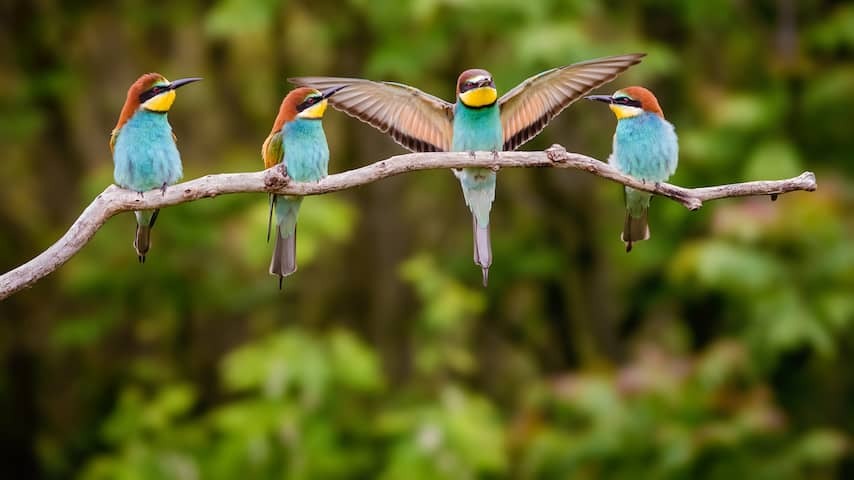
Due to climate change, colorful birds such as the bee-eater, hoopoe, and black-winged stilt are increasingly finding the Netherlands a suitable habitat. Enthusiasts are amazed, but is it really good news? “There’s a downside to it, of course.”
With a bright yellow throat, green-blue chest, and reddish-brown crown, the bee-eater looks tropical. The same goes for the almost orange hoopoe, with its striking crest with black tips. Or take the black-winged stilt: a stark white and black body with strikingly long pink legs.
These are birds that are being seen more and more often in the Netherlands due to climate change. Our country is becoming increasingly suitable for them to breed. Or their original habitat is becoming less so due to drought.
The bee-eater is the most striking of the newcomers in the Netherlands. “A magnificent creature. Absolutely my favorite bird,” says Hilbert Folkerts, co-founder of the Werkgroep Bijeneters Nederland (Bee-eater Working Group Netherlands). They keep track of the number of breeding pairs in the Netherlands and help where necessary with setting up breeding locations.
This year was a top year for the bee-eater in the Netherlands, with seventeen or eighteen breeding pairs. They bred this year in the provinces of Gelderland, South Holland, North Holland, and Zeeland. Out of fear of a massive influx of photographers, Hilbert keeps the exact locations secret. With its bright colors, the bee-eater is indeed quite photogenic.

Large insects easier to catch in the heat
The bee-eater’s enjoyment of the Netherlands is due to the increasingly warm summers. Large insects such as bees and bumblebees are then easier to catch. And that is what most of its food consists of – the name gives it away.
The hoopoe (the right bird in the photo above this article) is actually also a southern species, says Gert Ottens of Vogelbescherming Nederland (Bird Protection Netherlands). The crested bird bred in the Netherlands until the beginning of the last century, but always in the southern provinces.
Due to increasingly large farms, the landscape has become more monotonous. Many trees, hedges, and shrubs have been removed, which the hoopoe likes. “That scaling-up has only increased further. The fact that the hoopoe is breeding here again is partly because it has become warmer here,” Ottens explains.
Connection between rainfall in Spain and black-winged stilts here
The fact that all those colorful birds are increasingly finding the Netherlands is good for bird lovers. But they usually don’t come here out of abundance. That is shown, for example, by the black-winged stilt (middle photo below).
The number of breeding black-winged stilts has increased enormously in the Netherlands in recent years, according to the newly published annual breeding bird report from Sovon. To find their food, they need shallow water. Due to drought, that is not always available in Spain, where they used to be most common.
“There is a very clear connection between the number of black-winged stilts here and the amount of rainfall in Spain in the spring,” says Sovon spokesperson Albert de Jong. “Especially in recent years, it has been very dry in Spain.” From their wintering areas in Africa, they then move on to the Netherlands, where there is still enough water.
Cattle egrets benefit from milder winters
The number of glossy ibises also shows how dry it is in Spain. The glossy ibis (on the right in the photo below) does not yet breed here, but according to De Jong, it is only a matter of time.
From a distance, the glossy ibis seems to live up to its name. But if you see the bird up close and the sun shines on it, it turns out that black and brown body is suddenly also partly green.
The cattle egret also seems ostensibly boring: completely white and an orange beak. But wait until the breeding season. Then the cattle egret suddenly has an orange-brown chest and a large crest in the same colors, as can be seen on the left in the photo below.
That is increasingly visible in the Netherlands, because the number of breeding cattle egrets has increased significantly in recent years. De Jong: “They benefit from the milder winters here. They always migrated to the south in the winter, but more and more birds are staying here.”

Other species still to come
In addition to the glossy ibis, the short-toed snake eagle, melodious warbler, red-rumped swallow, and red-backed shrike (photo below) also do not breed here. Not yet, Ottens thinks. Because for many of these species, it is only a matter of time. “Climate change plays a role for the majority of them.”
Ottens is not sure whether he should be happy with the opportunity to see all those colorful birds in the Netherlands. “As a birdwatcher, I think it’s very nice to see those birds. But there’s also a downside to it, of course.”
De Jong also feels that way. “It is a beautiful sight, an enrichment for Dutch nature. But for example, those black-winged stilts, who come here because Spain is drying up, do send a signal. That is really problematic.”